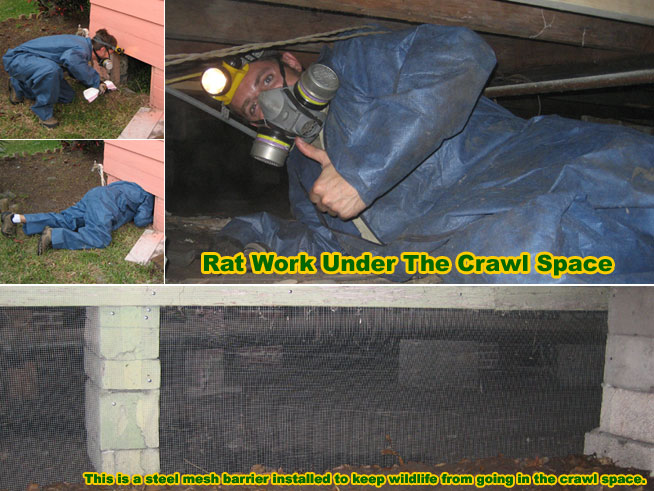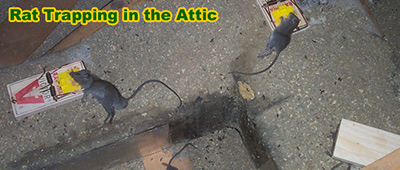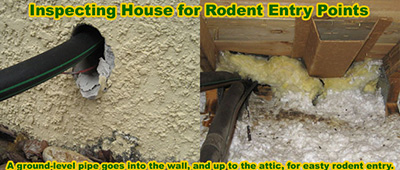Crawl space can mean some different things in various parts
of the country. Some people refer to an attic as a crawl
space. Some people refer to the area under a house as the
crawl space - this is, by my general understanding, the
correct part of the house to call a crawlspace. Still other
people will refer to other gaps in a house, even eaves and
such, as a crawl space.

Regardless of the area, the principles for getting rid of rats in the crawl space are the same. First up, find out how they are getting inside the building.
UNDER THE HOUSE CRAWL SPACE
It's pretty easy to crawl under a house and set rat traps. Be sure to wear a filter mask, so you don't breathe in too much dirt. The hard part is in keeping the rats from getting under the house. If your home is fairly well sealed, with only a few well-defined vent holes below the craw space, it's a piece of cake - just bolt in some proper steel mesh vent covers that rats can't chew through. If the perimeter of the house is open all around, then you've got a tough case. In the above photograph, you can see a steel screen installed all around the perimeter of the house, to keep rats out. I set traps under the house to trap the remaining rats stuck inside.THE ATTIC CRAWL SPACE
If you want to get rid of rats in the attic crawl space, you need to follow a series of steps:STEP 1: Find out how rats are getting inside the building. Those rats are entering your home and crawl space somehow. You will NEVER solve your rat problem unless you find ALL the entry points. You must inspect the whole structure, from the ground up, including all portions of the roof, and the plumbing system. Check vents, eaves, roof joints, plumbing stacks, AC chases, EVERYTHING. This page will help explain the inspection process in more detail: Rat Inspection.
STEP 2: Seal up all the entry points. That's right, seal them up first, even if there are many rats currently inside the building. If you leave the entry holes open, and then begin trapping or excluding the rats, guess what? Open holes mean more and more rats will keep coming in, and the job will never end. Read more about repairs on this page: Rat Repairs.
Learn how big rats can get.
STEP 3: Trap and remove the rats. You have three options here. First, you can use the standard lethal snap traps. Second, you can use live cage traps. Third, you can install a one-way funnel door exit on the primary rat entry/exit hole, if you have identified it. I have used all of these methods. I must say that I absolutely do use the lethal snap traps in the crawlspace. I have found this method is to be the most effective, and it's more humane than a slow, painful death by poisoning. Set the traps on the rodent runways, not haphazardly. Trap placement is absolutely key. Read more about the art of rat trapping here: How To Trap Rats.
Crawlspace Access
Most homes with an attic will have an obvious access opening in one of the bedrooms. This removable panel may be in the ceiling or in the wall, and it may be located inside of a closet or in another removed area. For homes with no mentionable attic, there is often a crawl space between the roof and the ceiling. Crawl spaces allow for home maintenance of wires and ducts and provide a cushion of air to help insulate the interior of the home. For buildings with this setup, the ceiling space may be access through a panel on the outside of the home. Regardless of the size of the space, if one is there, a newer home will have an access panel. It is possible that older homes do not have ready points of entry for ceiling spaces. Creating an opening is not as daunting as it may seem and can be accomplished with the use of a stud finder. By making a small opening in between studs the space above can be assessed. If the test site was accurate, a larger opening can then be made to allow a person to fit into the area. Care must be taken when entering a ceiling crawl space. Step or crawl only on the support beams. Placing your weight elsewhere may mean taking a fall through the less sturdy layers of material.THE SAME APPLIES TO MICE
Although I wrote this site with rats in mind, such as the Roof Rat and Norway Rat, the same principles apply to other rodents, such as the house mouse. Mice behave very similarly to rats, they're just smaller. Email me if you have any questions about how to get rid of a mouse in the crawl space, mice in the crawlspace, and rodent problems in the crawl space.Read about:
Rats in Foreclosure Home
Rats in New Jersey
Can Rats Live in a Hot Attic?
What do rat bones look like?
Do rats destroy insulation in an attic?
Do rats chew on wires? Why?
What can rats chew through?
Will a rat chew through the ceiling?









